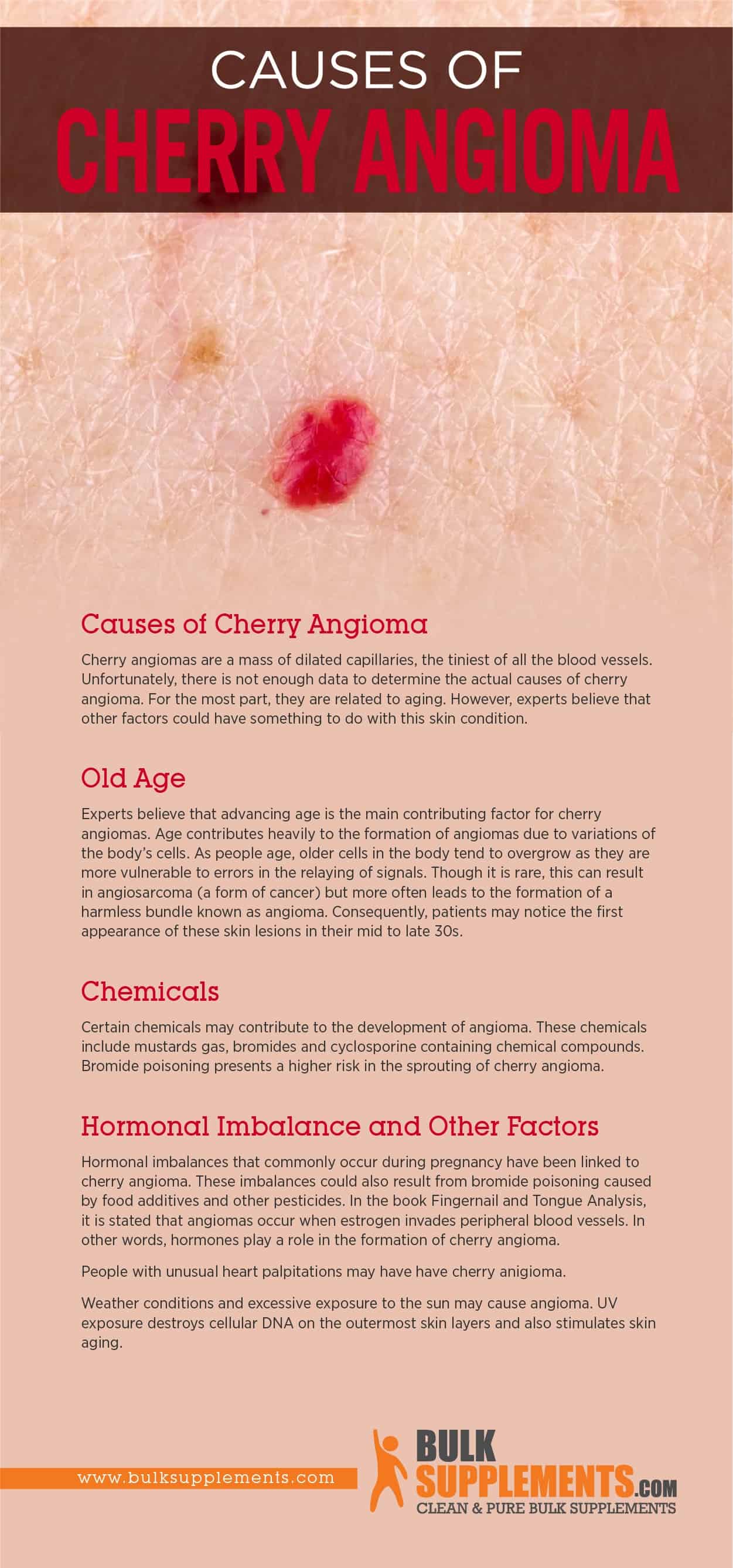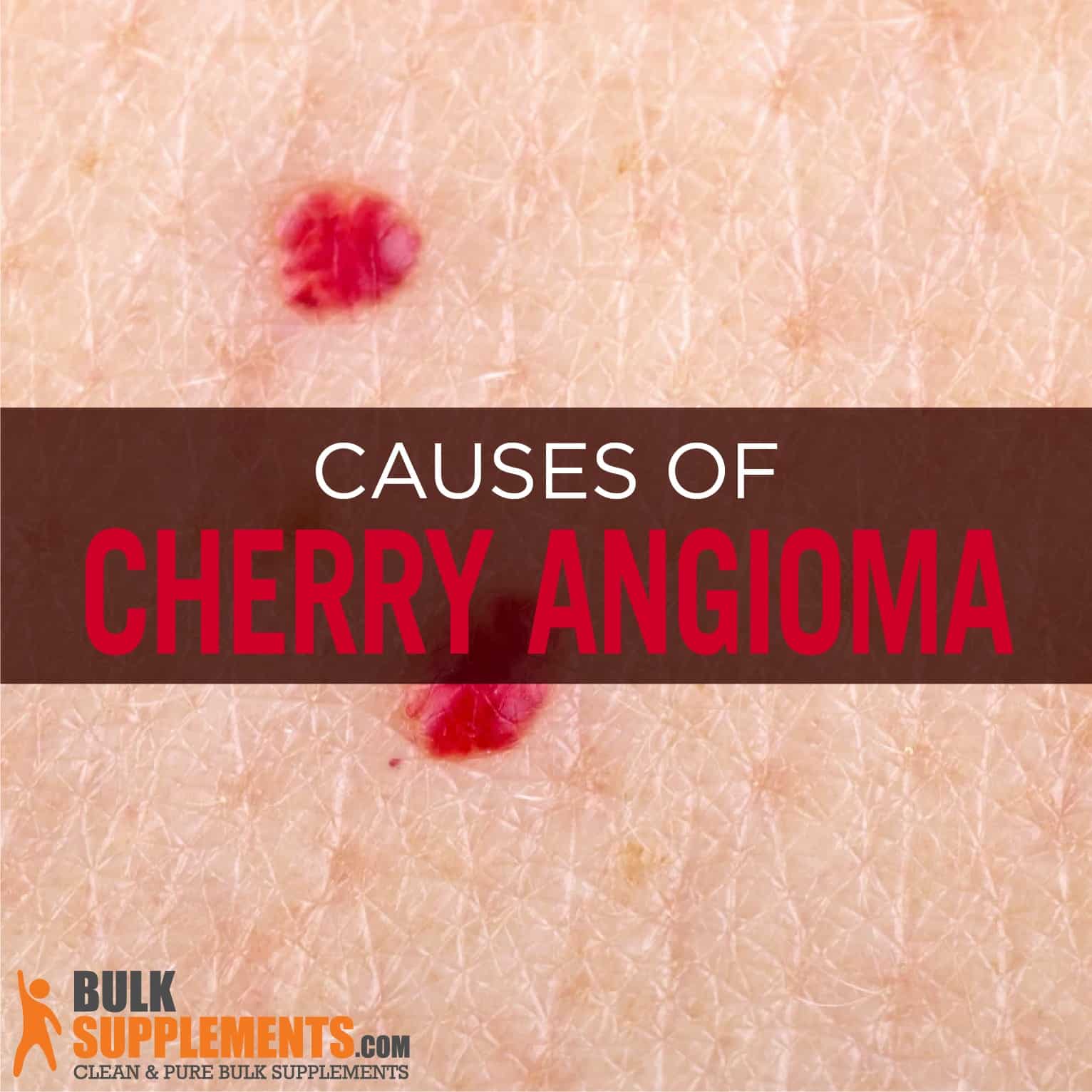What is a Cherry Angioma?
A cherry angioma is a skin disorder of mole-like tumors made up of small blood vessels, or capillaries. Thankfully, these tumors are benign because they do not affect the surrounding body cells, nor do they spread to other parts of the body. Though angiomas are not harmful, they could be signs of a more serious condition, like liver damage (x, x). Spider angiomas are common during childhood and sometimes during pregnancy (x).
Cherry Angioma Characteristics
Small Marks on Skin
The most common cherry angiomas characteristic is small, bright red marks on the skin. They can appear in other colors, like black, purple and blue. Cherry angiomas occur on a person’s trunk or abdomen. In rare cases, they will appear on the scalp, face, neck, arms, shoulders and upper chest area (x). Cherry angiomas often occur in groups.
A patient may experience some signs of irritation, like bleeding and swelling, particularly if the affected area is scratched, rubbed or picked. Bleeding can also occur if an individual shaves over the angioma (x).
Other Characteristics
Cherry angiomas may vary in size, although they commonly grow to a few millimeters in diameter. They are demonstrated as round lustrous domes and become larger over time. If the mole is round and dark with signs of redness extending from its center, it has the characteristics of a spider angioma.
Cherry angiomas are firm to the touch, especially at the center of the mole (x).
Causes of Cherry Angioma
Cherry angiomas are a mass of dilated capillaries, the tiniest of all the blood vessels. Unfortunately, there is not enough data to determine the actual causes of cherry angioma. For the most part, they are related to aging. However, experts believe that other factors could have something to do with this skin condition.
Old Age
Experts believe that advancing age is the main contributing factor for cherry angiomas. Age contributes heavily to the formation of angiomas due to variations of the body’s cells (x). As people age, older cells in the body tend to overgrow as they are more vulnerable to errors in the relaying of signals. Though it is rare, this can result in angiosarcoma (a form of cancer) but more often leads to the formation of a harmless bundle known as angioma. Consequently, patients may notice the first appearance of these skin lesions in their mid to late 30s (x).
Chemicals
Certain chemicals may contribute to the development of angioma. These chemicals include mustards gas, bromides and cyclosporine containing chemical compounds (x). Bromide poisoning presents a higher risk in the sprouting of cherry angioma (x).
Hormonal Imbalance and Other Factors
Hormonal imbalances that commonly occur during pregnancy have been linked to cherry angioma. These imbalances could also result from bromide poisoning caused by food additives and other pesticides. In the book Fingernail and Tongue Analysis, it is stated that angiomas occur when estrogen invades peripheral blood vessels. In other words, hormones play a role in the formation of cherry angioma (x).
People with unusual heart palpitations may have have cherry anigioma (x).
Weather conditions and excessive exposure to the sun may cause angioma. UV exposure destroys cellular DNA on the outermost skin layers and also stimulates skin aging (x).

The Significance of Cherry Angioma
Cherry angiomas and cancer are not related. If they develop in areas where irritation may occur due to clothing, bleeding may occur. But if a sudden outbreak of various lesions does occur, see a doctor. This could be a sign of an underlying problem like liver damage or hepatic fibrosis (x).
Differentiating from Cancer
Skin cancers may persist, enlarge or turn darker as an individual grows older, just like cherry angiomas. However, skin cancer often appears as unevenly shaped growths. On the other hand, cherry angiomas are consistently circular and grow in patterns. Considering this, you should seek medical attention if cherry angiomas occur irregularly. In fact, irregular patterns of lesions could be a sign of skin cancer (x).
Cherry Angioma Treatment
Indeed, these growths are usually benign, however they can become problematic since they can become irritated, bleed and wind up infected. Since many people want them removed for cosmetic purposes, doctors can remove cherry angiomas through surgical procedures. In most cases, a doctor will perform a biopsy to obtain a proper diagnosis and rule out more serious conditions.
Electro-Surgery
Electro-surgery is performed in the hope that the red moles are destroyed. In fact, a device is used to cut, dry, and completely remove the tissue. This method leaves no scars (x). In fact, this procedure can be performed on an outpatient basis using local anesthesia (x).
Laser Vaporization
During this procedure, a laser vaporizes the blood cells causing the vessel wall to close down and heal. Indeed, it works by focusing high heat into the lesions and restoring the natural appearance of the skin (x). Many regard it as the most effective and comfortable procedure (x).
Shave Excision
Shave excision involves removal of the lesions though the use of a blade. (x). To treat bigger lesions, shaving can be combined with electrocautery. It requires minimal stitching. At any rate, this procedure is one of the most popular conventional treatment for cherry angiomas.
Remedies and Supplements for Cherry Angiomas
Chamomile
Chamomile offers superb skin-healing benefits. As a matter of fact, it is one of the most popular herbs used to treat mild infections. If you plan to take chamomile as a dietary supplement, take 800 mg of chamomile powder once or twice daily with water, or as directed by your physician.
Coconut
Coconut oil can help with several skin disorders. For the simple reason that it boosts collagen production, it may reduce swelling or reduce the size of the mole when applied daily. Though there are not enough studies to show that it can aid in removing cherry angioma. At any rate, if you plan to supplement your diet with coconut, mix one tbsp. of coconut powder into water, smoothies and other drinks.
Apple Cider Vinegar
Applying fermented apple cider vinegar to cherry angiomas may lessen their appearance. It contains acetic acid, which can protect your skin from some types of bacteria. Recommended dosage of apple cider vinegar is a 500 mg capsule per day.
Other Remedies and Supplements
- Apply essential oils. Tea tree oil has been used as a remedy to treat different skin rashes, irritation and signs of inflammation. It is safe to use on cherry angiomas around the neck and face (x).
- Detoxification. Detoxification helps to boost liver health and hormonal balance. You can detoxify by taking plenty of antioxidant-rich organic foods like leafy green or green smoothies, avoiding the use tobacco and avoiding birth control pills.
- Limit chemical exposure. Coming into contact with bromide increases your risk of having cherry angioma (x). Therefore, it is beneficial to consume foods dense in natural iodine like eggs, strawberries, yogurt, salmon and sea vegetables.
The Bottom Line
Cherry angiomas are non-cancerous growths that are a collection of small blood vessels. They can vary in size, appearance and placement and are usually benign. There is no medical need to get rid of them, unless they begin to bleed, cause itching or are prone to infection. Though removal is not necessary, some individuals may wish to remove cherry angiomas for cosmetic reasons.


